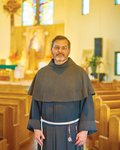

SILER CITY — Last December, the Virgin of Guadalupe went on a COVID-safe pilgrimage to her parishioners in and around Siler City.
This year, though, her people will once again go on pilgrimage to her.
Beginning Monday, parishioners could return to St. Julia Catholic Church to celebrate and revere the Virgin of Guadalupe with multi-day festivities associated with the church’s traditional celebration.
Each Dec. 12, Mexican and Mexican-American Catholics across the country congregate to honor and pray to the Virgin of Guadalupe, Mexico’s patron saint.
“It should be something very special this year since we can gather again as a community to celebrate the great feast of Our Lady of Guadalupe,” Father Julio Martinez told the News + Record. He leads St. Julia, which is over 85% Hispanic.
Much like last year’s celebration, preparations and festivities began in November. The week of Nov. 15, the church received the “Antorcha,” or torch, from Mexico. Carried by runners on foot from Mexico to parishes along the East Coast, the Antorcha contains fire from the Basilica of Our Lady of Guadalupe in Mexico City. Parishioners usually light a candle from the Antorcha, which runners then bring to the next parish for a similar ceremony; on Dec. 12, the torch arrives in New York.
“What it represents is the immigrants, our roots or our ancestors,” Jeronimo Prieto Medina told the News + Record last year. The Oaxaca native and his family participate as runners. “That’s why they started doing this ... We’re trying to keep our culture, keep our beliefs, our religion going.”
Following Monday’s start, St. Julia is hosting a series of activities leading up the Feast Day celebrations this coming weekend, according to Martinez. The church began offering children’s activities on Tuesday, including different games and a “surprise” Tuesday evening. Likewise, events on Thursday, Dec. 9, and Friday, Dec. 10, will be dedicated to married couples and families respectively.
“Friday is a family get-together,” Martinez said. “Everyone brings food and we have music and simply enjoy the gift of community and family.”
Saturday and Sunday, however, will be all-day affairs — literally. Celebrations on the actual Feast Day began in the early hours of the morning.
Starting at 10 a.m. on Dec. 11, the church will hold a festival to sell food — including pupusas, tacos, tamales and atoles, among others — followed by a procession with the image of Our Lady of Guadalupe at noon.
“This year the procession will also have about 10 horses and their riders, who accompany the image of Our Lady, which is carried by 12 men on their shoulders,” Martinez said. “There is also a band playing music ranchera as it is played in the country towns of Mexico in the procession. Our children and youth will also participate.”
The procession will start on Harold Hart Road and wrap around the church — located at 210 Harold Hart Rd. — until riders carry the image to the church’s plaza. At 5:45 p.m., mariachi bands will play.
The following day, celebrations will begin at 4 a.m. at the church with “Las Mañanitas,” which Martinez defined as “the serenading of Our Lady of Guadalupe that welcomes her into her feast day.” Closer to dawn, parishioners will gather for a “Mexican breakfast” of hot chocolate, tamales and pastries. The day’s mass will take place at noon with special music, tributes, poetry and dances.
“That is followed by a meal for everyone who comes,” Martinez said. “The church is packed to the gills. We will have tents with heaters placed outside the church so that people will eat as comfortably as possible. There will also be more music and dances.”
Who is the Virgin of Guadalupe, and why is she important?
In any Our Lady of Guadalupe Feast Day celebration, you’ll always find a large portrait of a dark-skinned woman draped in a green mantle. Golden light engulfs her, and a black cord wraps around her waist, symbolizing that she’s pregnant with her son, Jesus.
Mexicans know her as the Virgin of Guadalupe — and in Mexico, her story goes back nearly 500 years to Dec. 9, 1531, about a decade after the fall of the Aztec empire.
Juan Diego, an indigenous Mexican who’d recently converted to Catholicism, was walking across Tepeyac Hill (now in Mexico City) when a dark-skinned woman dressed like an Aztec princess appeared to him. Speaking in Nahuatl, his native language, she introduced herself as the Virgin Mary and instructed Diego to tell the local bishop to build a church on that hill in her honor.
At first, the bishop didn’t believe Diego and asked for proof. The Virgin agreed to make another appearance to Diego, so on Dec. 12, she instructed him to gather Castilian roses — which weren’t native to Mexico — place them in his coat and deliver them to the bishop. Upon opening his cloak, the roses spilled out and an image of the Virgin of Guadalupe miraculously appeared on Diego’s cloak.
Recognizing the “miracle,” the bishop constructed a small shrine on Tepeyac Hill and later built a larger church below, known today as the Basilica of Our Lady of Guadalupe. The original image still sits there today and draws millions of pilgrims each year.
For Mexican Catholics, the Virgin of Guadalupe isn’t just a religious icon; she’s ingrained into Mexico’s national identity. She’s mestiza — a mix of European and indigenous heritage, like many Mexicans — and appeared to a Mexican native, speaking his native tongue.
“There’s a great saying in Mexico that goes like this: ‘Mexico is Guadalupe, and Guadalupe is Mexico,’” Martinez told the News + Record last year. “You can’t separate the two. When you meet the Mexican Catholic people, that’s when you understand that.”
Reporter Victoria Johnson can be reached at victoria@chathamnr.com.